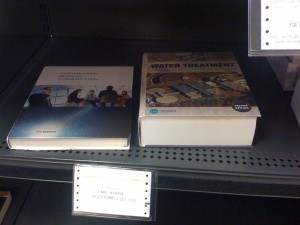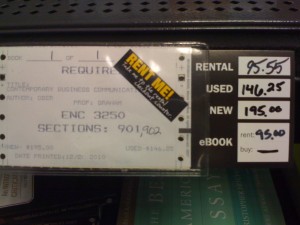Books, how do they work?
It's that time of year again. Time for all the students to partake in the slaughtering of the lambs.
When I first started attending USF, the bookstore was administered by USF. It didn't look much different than it does today, sans all the B&N lubricant sprayed copiously all over the place. The student textbooks were in the basement. The coffee shop was upstairs. Students were buying earlier versions of the same books. The only difference was that text books didn't cost as much or more than matriculation.
Here's an example of Academic Progress:
There are two books in these pictures. The book on the left is a Professional writing course book. Essentially it's a regurgitation of English Comp II, mixed with a little Sociology and a twist of business. Nothing to see here. It's basic- almost outdated information that is questionably relative in this modern e-conomy.
The book on the right is a graduate level tome on Water Treatment Systems. It's visually two and a half times the thickness, and contains vast expanses of differential equations, stereo chemistry, physics, and fluid dynamics. Flipping through the pages gave me flashbacks to my engineering core.
Beyond the size and informational density/scope of each book, there is one major difference between these books. Can you guess? I bet you can't. It's hard to see because its not in the picture. The reasoning is arguably financial. One book is highly specialized and will only be utilized by a handful of students. The other is broad and general and will be a required class for every single College of Business student. Literally hundreds of students every semester.
Having been a student that excelled at Microeconomics, I can with a high degree of confidence state that the laws of supply and demand are true and predictable. Unless, someone has a reason or incentive to mess with them. A book so specialized and unique that will sell only a dozen or so copies a semester, that is four inches thick, would be a low volume text. Hence it's cost would be greater compared to a more mass produced book of smaller stature. In my opinion significantly more resources are needed to produce the book on Water Treatment than a book on how to write a resume.
So what does this financial motivation look like? Let us stare the beast in the eye:
If you compare the two based on volume of information, degree of difficulty, number of pages, and scarcity, these prices are not possible. Unless the publisher or some other organization is subsidizing the cost of the Water Treatment text, someone is getting bent over.



